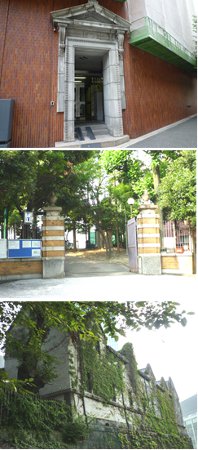On the south side of Nihonbashi is the Nihonbashi Miyuki Building, which houses the Nihonbashi Central Branch of the Bank of Tokyo-Mitsubishi UFJ. There is an old entrance left toward the Nomura Securities Building on the northeast side. This is the entrance and exit of the former Murai Bank in this place (above photo).
 Murai Bank was founded by Kichibee Murai, a native of Kyoto, in 1864 (1864)-1926 (1926). During the Meiji era, Murai was called the "Oriental Tobacco King" due to the privatization of tobacco, and manufactured and sold Japan's first double-cut tobacco "Sunrise" to build a huge wealth. It is said that he competed for advertising with "Tengu tobacco" by Matsuhei Iwaya, Ginza, Tokyo.
Murai Bank was founded by Kichibee Murai, a native of Kyoto, in 1864 (1864)-1926 (1926). During the Meiji era, Murai was called the "Oriental Tobacco King" due to the privatization of tobacco, and manufactured and sold Japan's first double-cut tobacco "Sunrise" to build a huge wealth. It is said that he competed for advertising with "Tengu tobacco" by Matsuhei Iwaya, Ginza, Tokyo.
In 1904 (1904), when tobacco became a monopoly system, he gained enormous compensation and founded Murai Bank and advanced to Tokyo mainly in Kyoto. Initially, the branch was Odenmacho 1-chome, but in 1913 (1913), it was relocated to the Nihonbashi triangular area to Japan's first reinforced concrete building in the Renaissance style. In 1927, the financial crisis broke down and went bankrupt. In addition, he established Murai Kisen, Murai Mining, and Imperial Paper.
Kichibee Murai's residence was located on the site of Hibiya High School in Nagata-cho, Chiyoda-ku, near Hie-jinja Shrine. In 1912 (1912), he moved to this land of about 5,000 tsubo, and completed in 1919 (1919), the building was completed in 1919 (1919). It was called "Sanno-so". After the bankruptcies, it was relocated as the Shoin of Enryaku-ji Temple.
Murai died suddenly in 1926 (1926), and his residence was sold to Tokyo due to bankruptcies in 1927 (1927), and in 1929 (1929), Prefectural Ichinaka (currently Hibiya High School) moved from Nishi Hibiya. The gate pillar of the old residence is still used as the main gate of the school building (center of the photo). The old art warehouse facing Shinsaka (commonly called late hill) on the Mexican embassy side is also maintained as a museum and still exists (bottom photo).
By the way, Hibiya High School moved to 3-15 Tsukiji, Kyobashi-ku (currently around the Togaku Building) in June 1887 as Tokyo Prefectural Junior High School in June 1887, and was renamed Tokyo Prefectural Junior High School in 1899 (1899). Until March, it was located in Tsukiji for about 12 years. The prefectural craft school (now Tokyo Metropolitan Crafts High School) opened on the site in April 1907 (1907). @ Akira Makibuchi

